
The longhorn beetles (Cerambycidae), also known as long-horned or longicorns, are a large family of beetles, with over 35,000 species described. Most species are characterized by extremely long antennae, which are often as long as or longer than the beetle's body. In various members of the family, however, the antennae are quite short and such species can be difficult to distinguish from related beetle families such as the Chrysomelidae. The scientific name of this beetle family goes back to a figure from Greek mythology: after an argument with nymphs, the shepherd Cerambus was transformed into a large beetle with horns.

Lamiinae, commonly called flat-faced longhorns, are a subfamily of the longhorn beetle family (Cerambycidae). The subfamily includes over 750 genera, rivaled in diversity within the family only by the subfamily Cerambycinae.
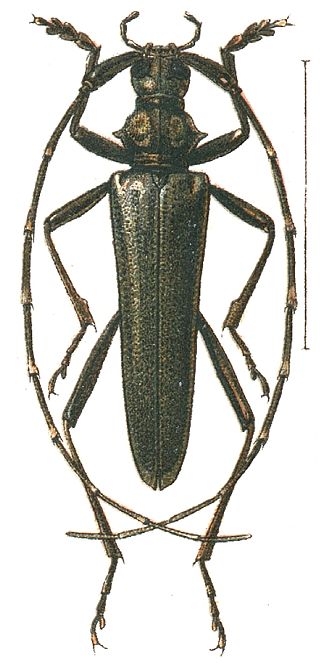
The Disteniidae are a small family of beetles in the superfamily Chrysomeloidea, traditionally treated as a group within the Cerambycidae.
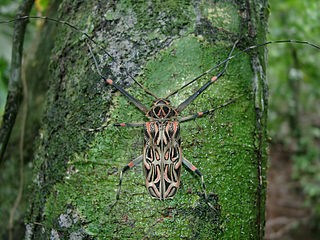
The harlequin beetle is a large and distinctly colored species of longhorn beetle from the Neotropics and the only member of the genus Acrocinus.
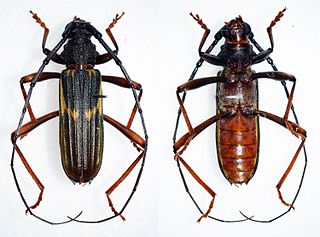
Bothriospilini is a tribe of beetles in the subfamily Cerambycinae, containing 11 genera which have a primarily neotropical distribution. The tribe was proposed in 1950 by Brazilian entomologist Frederico Lane as a member of the new subfamily Bothriospilinae, and with Bothriospila assigned as the type genus. The tribe is morphologically close to the tribe Torneutini, with which it has in common the same shape of the last abdominal segment, which is wide and largely braided in the female, as well as the anterior thigh cavities that are open from behind and the laterally open medial cavity.
Ranqueles is a genus of beetles in the family Cerambycidae. The genus was circumscribed by French entomologist Pierre-Émile Gounelle in 1906, with the South American R. mus assigned as the type, and at that time, only species. It now contains the following species:
Oxylymma is a genus of beetles in the family Cerambycidae. The genus occurs in Central and South America, from Guatemala to Bolivia and Brazil.

Trachyderini is a tribe of long-horned beetles in the family Cerambycidae. There are at least 140 genera and 650 described species in Trachyderini.

Parevander xanthomelas is a species of beetle in the family Cerambycidae. It was described by Félix Édouard Guérin-Méneville in 1844, and has been classified in the genus Parevander since the circumscription of that genus by Per Olof Christopher Aurivillius in 1912.
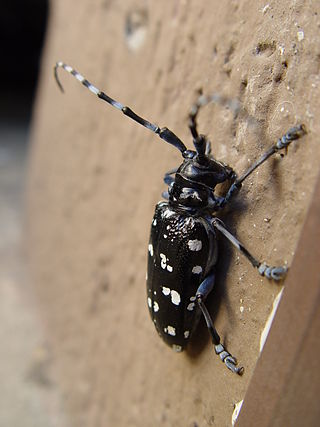
Anoplophora is a genus of beetles in the longhorn beetle family (Cerambycidae). They are native to Asia. Most are large and colorful and thus are depicted in artwork and sought after by beetle collectors. The genus also includes several notorious pest insects.

Neoptychodes trilineatus is a species of flat-faced longhorn beetles in the subfamily Lamiinae.
Chlorida spinosa is a species of beetle in the family Cerambycidae. It was described by Per Olof Christopher Aurivillius in 1887. It is known from Colombia, Bolivia and Peru. Adult males produce (6E,8Z)-6,8-pentadecadienal, an attractant pheromone.
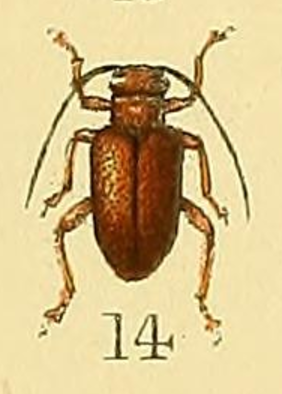
Entelopes is a genus of longhorn beetles of the subfamily Lamiinae, containing the following species:
Obereoides joergenseni is a species of beetle in the family Cerambycidae. It was described by Bruch in 1911. It is known from Brazil and Paraguay.
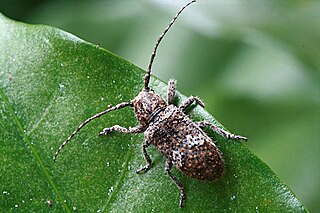
Rhytiphora bankii is a species of beetle in the family Cerambycidae. It was first described by Johan Christian Fabricius in 1775, under the genus Lamia. It is known from Australia, the Philippines, Borneo, Java, Micronesia, New Guinea, Hawaii, Moluccas, Sumatra, Vietnam, and has been introduced into Japan. The Australian species of Prosoplus were synonymised with Rhytiphora in 2013.
Megaderus is a genus of long-horned beetles in the family Cerambycidae. There are at least two described species in Megaderus.

Polycaon is a genus of horned powder-post beetles in the family Bostrichidae. There are at least four described species in Polycaon.

Zonopterus is a genus of beetles in the family Cerambycidae. Like most members in the tribe Callichromatini, species in the genus are brightly coloured with bands across the elytra. Most species in the genus are restricted to Southeast Asia with one species occurring in the Western Ghats of South Asia which is closely related to the type species Zonopterus flavitarsis from the eastern Himalayas. The genus was named by Frederick William Hope using the Greek roots ζώνη for belt describing the insect as "belted winged".

Coptocercus is a genus of beetles in the family Cerambycidae, mainly found in Eucalypts.
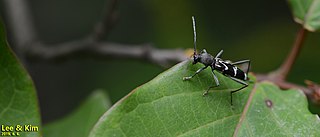
Rhaphuma is a genus of typical longhorn beetles in the family Cerambycidae. There are more than 200 described species in Rhaphuma.















